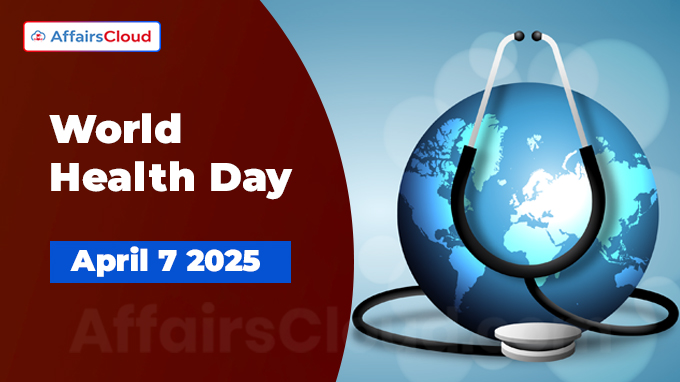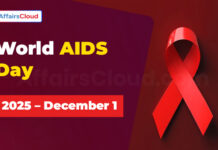 The United Nations (UN’s) World Health Day is observed annually across the globe on April 7, to raise awareness about a specific health issue that is of global concern.
The United Nations (UN’s) World Health Day is observed annually across the globe on April 7, to raise awareness about a specific health issue that is of global concern.
- April 7, 2025, marks the observance of the 77th anniversary of the founding of World Health Organization (WHO) in 1948.
2025 Theme:
The theme for World Health Day 2025 is “Healthy Beginnings, Hopeful Futures,”.
- It highlights the importance of maternal and newborn health, urging nations to eliminate preventable deaths and prioritize the well-being of women and infants.
Background:
i.World Health Day has been observed every year on April 7 since 1950, following WHO proposal during the First World Health Assembly (WHA) held in 1948.
ii.April 7 marks the founding of the WHO in 1948 and serves as a global platform to highlight critical health issues and raise awareness worldwide.
Note: WHO sponsors the World Health Day every year in collaboration with other related health organizations to promote global health awareness.
2025 Events:
On 7 April 2025, the WHO organized a hybrid event titled “Healthy Beginnings, Hopeful Futures: Global Action for Women and Newborns” as part of World Health Day 2025 observance.
- The event focused on reviewing the progress and ongoing challenges in maternal and newborn health, presenting new data, and identifying key opportunities to enhance survival rates and ensure better health outcomes for mothers and infants globally.
Events In India:
i.In alignment with World Health Day 2025, the Morarji Desai National Institute of Yoga (MDNIY) in New Delhi (Delhi) under the Ministry of AYUSH (Ayurveda, Yoga & Naturopathy, Unani, Siddha and Homoeopathy), organized the Yoga Mahotsav 2025 at Kalinga Stadium, Bhubaneswar, Odisha.
ii.This event marked the 75-day countdown to the 11th International Day of Yoga (IDY) on June 21, 2025 under the theme of “Yoga for One Earth, One Health”.
iii.The event was graced by Union Minister of State (MoS) (Independent Charge) Prataprao Ganpatrao Jadhav, Ministry of Health and Family Welfare (MoHFW).
Global Maternal and Child Health Crisis:
i.Approximately 300,000 women die annually due to pregnancy or childbirth complications.
ii.Additionally, over 2 million newborns die within their first month, and around 2 million more are stillborn.
iii.80% of countries may miss 2030 maternal survival targets; 33% may miss newborn mortality reduction goals.
India’s Health Milestones:
The Ministry of Health and Family Welfare (MoHFW), Government of India (GoI) has achieved significant progress through initiatives like Ayushman Bharat Yojana(ABY), National Health Mission (NHM), and digital health programs.
1.Maternal and Child Health Improvements:
i.Maternal Mortality Ratio (MMR): Fell from 130 (2014–16) to 97 (2018–20) per 100,000 live births.
ii.Neonatal Mortality Rate (NMR): Decreased from 26 (2014) to 20 (2020) per 1,000 live births.
iii.Infant Mortality Rate (IMR): Reduced from 39 (2014) to 28 (2020) per 1,000 live births.
iv.Under-5 Mortality Rate (U5MR): Declined from 45 (2014) to 32 (2020) per 1,000 live births.
v.30-Year Decline (1990–2020):
- MMR: 83% reduction (Global average: 42%).
- NMR: 65% reduction (Global: 51%).
- IMR: 69% reduction (Global: 55%).
- U5MR: 75% reduction (Global: 58%).
2.ABY – Health Infrastructure:
i.As of April 5, 2025, over 1.76 lakh Ayushman Arogya Mandirs (AAMs) are operational, providing comprehensive primary healthcare.
ii.As of 30th November 2024, over 17,000 government health facilities are certified under National Quality Assurance Standards (NQAS) to ensure quality improvement and patient-focused care.
3.Digital Health Initiatives:
i.Ayushman Bharat Health Accounts (ABHA):
- Over 76 crore ABHA Identifications (IDs) have been created as of April 5, 2025.
- Over 5.95 lakh healthcare professionals, 3.86 lakh health facilities registered; 52 crore health records digitized.
ii.U-WIN Immunization Platform
- Tracks vaccinations for pregnant women and children (0–16 years),enabling flexible, anytime-anywhere vaccine access under the Universal Immunization Programme (UIP).
- 7.90 crore beneficiaries registered; 29.22 crore doses administered (as of December 15, 2024).
iii.eSanjeevani Telemedicine:
- As of April 6, 2025, e-Sanjeevani (India’s National Telemedicine Service) has provided over 36 crore teleconsultations since its launch in 2020.
4.Disease Control Achievements:
i.Malaria: 69% drop in cases and 68% fewer deaths (2017–2023). India exited WHO’s High Burden to High Impact (HBHI) group in 2024.
ii.Trachoma: Eliminated as a public health problem (2024).
iii.Measles-Rubella: 50 districts measles-free; 226 districts rubella-free (as of March 6, 2024).
iv.Tuberculosis (TB): According to WHO’s Global TB Report, India’s progress in TB under National Tuberculosis Elimination Programme (NTEP)
- 17.7% decline in incidence (237 to 195 per lakh, 2015–2023).
- 83% reduction in “missing” TB cases (15 lakh to 2.5 lakh).
v.Kala-azar: Eliminated nationwide in October 2024 (<1 case per 10,000 population).
5.Ayushman Bharat – PM Jan Arogya Yojana (AB-PMJAY):
AB PM-JAY, launched in 2018, is a health insurance scheme for low-income families in rural and urban areas .As of December 20, 2024, more than 55 crore beneficiaries from India’s bottom 40% economically vulnerable population are covered under a Rs. 5 lakh health insurance per family.
- Over40 crore Ayushman Cards have been issued as of 3rdApril 2025.
- Overall, 31,846 hospitals (17,434 public and 14,412 private)have been officially empanelled under the scheme as of 3rd April 2025.
About World Health Organization (WHO):
Director General(DG) – Tedros Adhanom Ghebreyesus
Headquarters – Geneva, Switzerland
Founded – 1948




